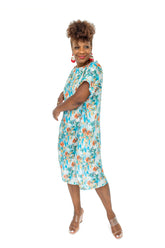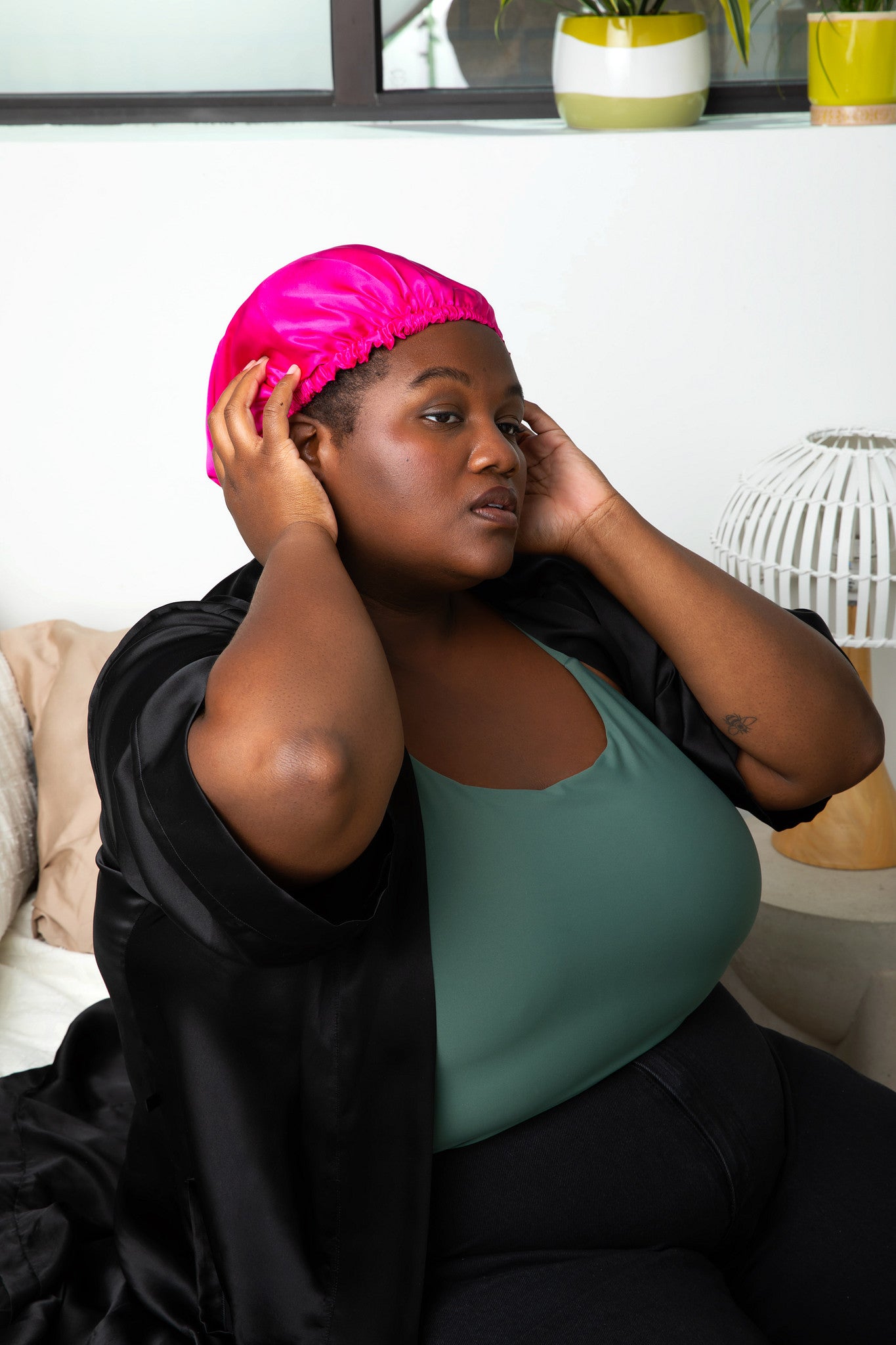A Visual Guide: 3 Easy Head Wrap Styles for 4C Natural Hair
Whether you identify with the term head wrap or head scarf, the goal is the same - to find a protective style that meets both function and fashion. We often use the terms interchangeably. Depending on your hair texture, protective styles like head wraps are a utility garment that represent more than just a cute hair accessory. When you take a magnifying glass to the shaft of 4C natural hair, the hair strand most closely resembles a coil. While natural hair is often revered for its ability to defy gravity and adhere easily to different shapes, it’s a notoriously difficult texture to manage. Curly textures are drier than straight hair textures because it takes the scalp’s natural oil a longer time to navigate down the hair shaft.

This translates into excessive breakage and heavy investment of time and product designed to keep the ends of the hair moisturized. This need of 77+ million US consumers drove a 2.9 billion dollar black hair care industry in 2022. The industry is expected to surpass 6 billion dollars by 2026. According to the black female consumers polled in the Mintel study, nearly 81% agree that healthy hair is the ultimate hair accessory. That’s why many opt for low manipulation hair styles and protective styles like head wraps that allow the hair shaft to maintain moisture and reduce breakage.
Low manipulation hair styles often refer to braids, twists and wigs. Any style that allows the shaft’s fragile, dry ends to be safely tucked away from nature’s elements for long periods of time qualifies as a low manipulation style. On the other hand, protective styles can extend to fabrics such as head wraps, bonnets and hats. However not all fabrics are healthy for 4C natural hair. It’s important to opt for low absorption fabrics like satin and silk when selecting protective styles. Remember how difficult it is for coily hair textures to retain moisture due to its spiral structure! Unlined fabrics like cotton and linen, while beautiful and comfortable, can reverse hours spent on deep conditioners and hair masks. These moisture wicking fabrics are great for managing sweat but can snag on the hair strand, accelerate breakage and dryness. Delicate fabrics like silk and satin handle curly strands with care due to their smooth properties. Luckily for shoppers protective style options on the market have continued to evolve in both quality and sophistication. This is progress given the legal origins of head wraps in the United States.
Legal Origins of Head Wraps in the United States
Historically, women wore head wraps in Africa as ornate symbols of pride, culture, and identity. But did you know there were U.S. laws in the 1700’s that made it mandatory for African-American women to wear their hair “bound in a kerchief”? In the U.S. head wraps were used as symbols of oppression—they were markers of enslavement to make African-American women feel less desirable and powerful than their white counterparts. Times have certainly changed since then.
Today, head wraps are a quick and easy protective hairstyle for all types, but specifically popular among 4c natural hair textures. You see plenty of bloggers and celebrities wearing bold head wraps not only for the style, but also for the functionality. You might even wear a head wrap to travel or do some quick errands—because not having the time to style your natural hair doesn’t mean that you shouldn’t look cute, right? With that said, many women still aren’t completely comfortable wearing head wraps because they feel that the look isn’t accepted in corporate America.

The good news is that the widespread uncertainty of head wraps in the workplace is shifting from the sidelines to the mainstream equity discussion. New York and California have adopted the Crown Act, a law prohibiting natural hair discrimination in the workplace.
If you’ve been toying with the idea of wearing a head wrap, but you’re not sure how to pull it off, consider these head wrap styles.
Head Wrap Styles for 4C Natural Hair
The beauty of head wraps is their versatility. While it takes practice and muscle memory to find the styles that work best for you, head wraps have the ability to transform your outfits. Try these styles and tell us how they work for you!
Head Wrap Style Idea #1: The Top Knot
- Step 1: Center the head wrap on your head and bring the two ends of the fabric together at the top of your forehead. Make a knot. Pro tip! Be mindful of whether you want the fabric to cover the top of your ears or prefer to wear it higher on your head. This knot should be the tightest and most secure because it’s the foundation of the rest of the style.
- Step 2: Make a second knot slightly behind the base knot. Pro tip! You should have a small gap at the top of your head that is uncovered. Continue to push the gap back to the top of your head, away from your forehead. If needed revert to Step 1 and widen the gap by tightening the two loose ends of the head wrap and pulling the gap apart.
- Step 3: Make a third knot slightly behind the second knot. Pro tip! You can make the second and third knots looser than the first knot. This gives the head wrap some more volume.
- Step 4: Peel the gap on the top of your head forward and tuck in the two head wrap tails and knots. Adjust accordingly. Pro tip! Some people like to pull the head wrap down to the top their ears to feel more secure.
Round out the look: Pair with a pencil skirt, form fitting top, professional blazer and wedges. You can opt for hoop earrings or a simple stud like pearls.
Head Wrap Style Idea #2: The Eryka Badu
- Step 1: Place the head wrap on your head making sure one side is slightly longer than the other. Bring the two tails of the fabric together towards your forehead and cross the ends. Pro tip! To make a symmetrical V shape, you may need to angle your left or right tail slightly higher than the other. Make sure the head wrap fits securely on your head, the first step is the most important. It’s ok to repeat Step 1 if you need.
- Step 2: Cross the head wrap tails at the back of your head and bring towards the forward. Pro tip! You’ll notice this motion creates natural pockets in your head wrap. You’ll need these in the next step! Use your pointer finger to find the folds and slightly pull the pockets forward.
- Step 3: Depending on whether you’re left handed or right handed, use your less dominant hand to tuck the first tail into a pocket you created in Step 2. Pro tip! Peel open the pockets and tuck in the tail to secure the head wrap.
- Step 4: Use your dominant hand to wrap the longer tail around the head wrap, careful to cover any openings. Reference the video for ideas on how to angle the longer tail so that you achieve the desired look. Once you’ve wrapped the longer tail around your head, tuck the tail into a pocket you created in Step 2. Pro tip! Experiment with the angle that you hold the two tails of the head wrap as this will determine the shape of the Eryka Badu head wrap style. Don’t be afraid to experiment with a few different angles, repetition is key!
Round out the look: Pair this head wrap with a form fitting tank top, t-shirt or halter top. Pair with a high waisted skirt and simple jewelry to create a timeless look. Alternatively, find your favorite African-inspired staple jewelry to hone in the look.
Head Wrap Style Idea #3: The Halo (00:47 Mark)
Step 1: Center the head wrap on your head and bring the two ends of the fabric together at the back of your head. Make a knot. Pro tip! Be mindful of whether you want the fabric to cover the top of your ears or prefer to wear it higher on your head. This knot should be the tightest and most secure because it’s the foundation of the rest of the style.
Step 2: Hold the two tails of the head wrap and bring the fabric together at the front of your head. Make a second knot. At this stage, you’ll have a knot at the back of your head and a second knot at the front of your head. Pro tip! Allow the second knot to give you some body. Remember, the first knot should be the most secure, tightness depends on your personal preference. The second knot can be a bit looser. Adjust the two tails by peeling open the fabric.
Step 3: Hold the two shorter tails at the top of your head from the second knot. Tuck in each tail to the pockets naturally created in Step 2. Pro tip! Use your thumb and pointer finger to tuck the shorter tails into the pockets. It helps to angle the fabric so you start with the triangle and fold the rest of the tail into the pocket. This ensures the loose ends are secured. You may have to do this a few times.
Step 4: Adjust the head wrap to your desired height and volume. Pro tip! Slide the head wrap back from your forehead to slightly above your hairline. This small tweak creates an added layer of volume and definition.
Round out the look: Our favorite travel head wrap style, this offers great neck support for long treks on trains and airplanes. Don’t be afraid to layer with long jackets or cardigans. This head wrap style pairs effortlessly with tassel earrings, drawstring pants and wedges. Hello chic bohemian!
3 Keys to Tying a Head Wrap
Head wraps take patience, trial and error. They can be an incredible option for protective styling for your natural hair, especially because it requires minimal manipulation and reduces the chances of breakage. The 3 keys to learning to tie a head wrap are patience, repetition and muscle memory.
We hosted a See One, Do One, Teach One Head Wrap Tutorial series at the World Natural Hair Expo in 2022 to help head wrap lovers unlock the three keys. If you missed the session, don’t worry you can do it at home with family and friends. First, watch one of the many tutorials on our website. This step is known as See One. Next, repeat the same head wrap style on yourself. We recommend you try at least three times because muscle memory will start to develop and build your confidence. This step is known as Do One. Lastly, teach one of your family or friends who also want to experiment with different head wrap styles. This is known as Teach One. Teaching the same style helps to cement the process in your head and reinforce what you’ve learned.
Remember it takes patience and practice! Repetition is key. One day, you’ll be able to tie head wraps effortlessly and confidently just like Demetria. On that note, let’s close by dancing it out!
Drop us a line in the comments and share your thoughts! Are you a part of our social community? Follow us at @shoprubysampson on all channels. Subscribe to our mailing list to unlock secret sales, early access to product launches, natural hair and styling tips.





